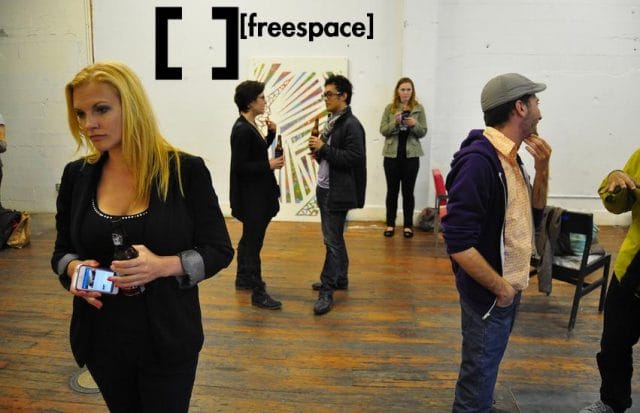
What could you do if you had the space and social infrastructure to freely organize around creative ideas and projects in your city? Last year, a group of hackers, social activists, and community leaders in San Francisco banded together to answer this question.
Their brainchild, [freespace], aims to provide “temporary spaces for lasting change:” the coalition works with charitable landlords and property owners to rent huge vacant warehouse spaces for $1 per month; then, they give these spaces to the community for open-use.
Now in its second iteration, [freespace] has become a melting pot of San Francisco culture: tech workers with six-figure salaries mingle with self-proclaimed hippies; artists and musicians swap ideas with entrepreneurs and Stanford MBAs; murals are communally painted by hackers and hobos. At first glance, [freespace] is something of a social utopia.
What exactly are the principles behind this movement, how was it orchestrated, and what are its future implications?
The First Location: 1131 Mission Street
In January 2013, The White House announced the National Day of Civic Hacking as part of an initiative to increase government transparency and civic engagement. For two days in June, government agencies like NASA, The Department of Labor, and The Census Bureau would release data to the public for hackers to build tech with. While the intention was for bright minds to create new apps for the government, a few people in San Francisco interpreted it differently: it also sought to bring people together to improve their communities.
Mike Zuckerman (a “culture hacker” and ex-Yahoo employee), Morgan Fitzgibbons (a community organizer and University of San Francisco lecturer), and Ilana Lipsett (a community mapper and economic development consultant) banded together and began to think about hacking San Francisco real estate. The three pooled their resources and, with support from the Mayor’s Office of Economics and Workforce, the team was put in touch with a real estate agent who showed them an available 14,000 square foot warehouse at 1131 Mission Street in SOMA, near downtown San Francisco.
They contacted Ron Stolowitz, the building’s owner, with a crazy proposal: they would rent his property (valued at $20 per square foot, annualized) for $1, and turn it into an open space for the community. Stolowitz, whose building had once housed a sewing machine business, was hesitant at first:
“I never thought I’d do this, have a bunch of kids in the space. I didn’t quite comprehend the whole concept. I didn’t know what they were saying, exactly. There are lectures, meetings, yoga programs? And the whole concept is everyone can go.”
But the trio convinced him that activating his long-vacant building would bring unbridled attention, publicity, and new people to the space. Stolowitz realized that the move might revitalize interest in his property, and he agreed to rent his building for the month of June, for $1.
The group coined a name for their initiative — [freespace] — and mobilized a massive cleanup effort. Within a few days, the space was opened up to the community, who covered the walls with murals and organized free, independently-run events.
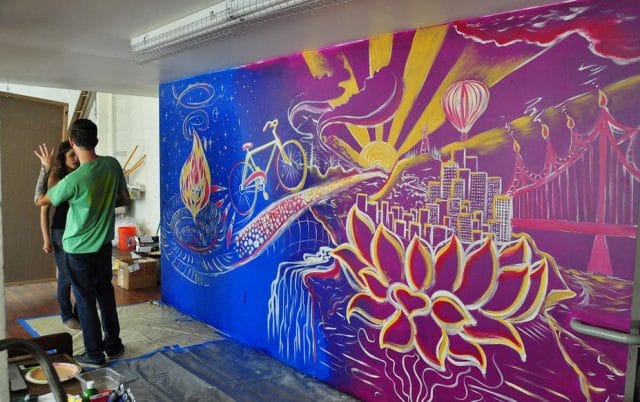
A mural inside [freespace]’s first building; Source: Eoin McMillan (Flickr)
[freespace] developed a philosophy: they’d provide the warehouse, and people would do the rest. Only a few rules were established: no alcohol, no drugs, no money, and (because of one unfortunate incident) no public masturbation. Other than that, the community was given free reign at 1131 Mission Street.
In a month, 119 free events were hosted, ranging from tech-focused meetings to yoga classes. Burner Hack hosted “Burning Man themed hackathons” in which participants could “hack on blinky lights, costumes, and interactive body piercings;” the Yellow Bike Project shared free tutorials on bike maintenance and craftsmanship; a local chef organized a massive Valencian paella party.
There were silent discos, movie screenings, and WordPress workshops. The space even hosted a “crafternoon” session for Kindergarten students to paint and garden. One Thursday night featured a “digital detox” party, during which tech-clad San Franciscans shed their computer companions for several hours, and turned off smartphones, tablets, and music players; 711 people attended.
It also became a hub for creative, socially-minded hackers. Super Happy Dev House, a collective of hackers that “combines serious and not-so-serious productivity with a fun and exciting party atmosphere” turned [freespace] into a hackathon hotspot. A visitor described the scene at one such event:
“[freespace] was buzzing with energy when I stopped by to visit. Laptop cords were strewn around tables as ad hoc teams worked on different projects and individuals brought their own to work on in the communal environment. It was less structured than Science Hack Day but it had the same esprit de corps of collaboration and hacking.”
With an uncertain future for its space, [freespace] turned to crowdfunding site, Indiegogo, and launched a campaign to pay for one more month at market rate — $25,000. Over 280 people contributed to make that happen and 1131 Mission Street remained open for 30 more days.
By the time funding ran dry and the building’s owner placed his property back on the market, [freespace] had seen 6,000 people come through the property, had hosted 209 events (95% of which were community-led), and had bred a form of civic engagement in which community members from all facets of society could share a space and create something special.
In August 2013, [freespace] began hunting for another place to call home.
The Second Location: 1011 Market Street
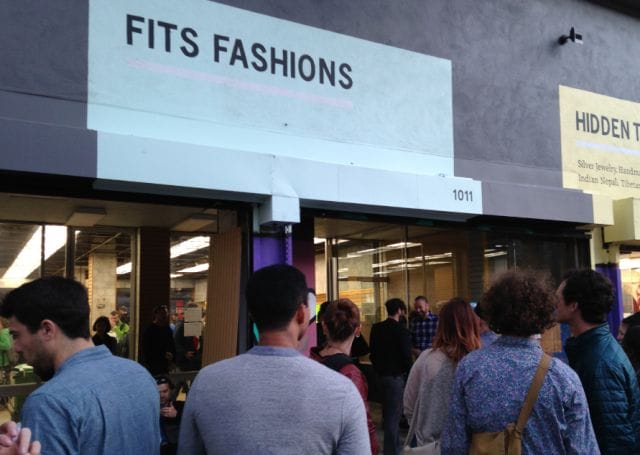
Last week, [freespace] once again secured a three-story warehouse — this time at 1011 Market Street in downtown San Francisco — for three months at $1 per month. According to City Data, the building is owned by Federal Realty Company/Will Thatcher and had a total assessed value of $533,000 in 2009.
The space’s ceremonial opening party, hosted last night, saw an incredible variance of people: shirtless fanny-pack toting dancers, businessmen in Armani suits, handlebar-mustachioed honky-tonk piano players, DJs in cat masks, elementary school students and elderly women building rainbows together in a Lego-filled room — [freespace] wasted no time in launching their second iteration, and the community wasted no time in occupying the space.
The warehouse, which once housed a discount women’s clothing store and a photography gallery, consists of three floors: a basement (which is in need of a major cleanup effort), a main floor (which includes dressing rooms), and an upstairs space.

Main floor of new Freespace
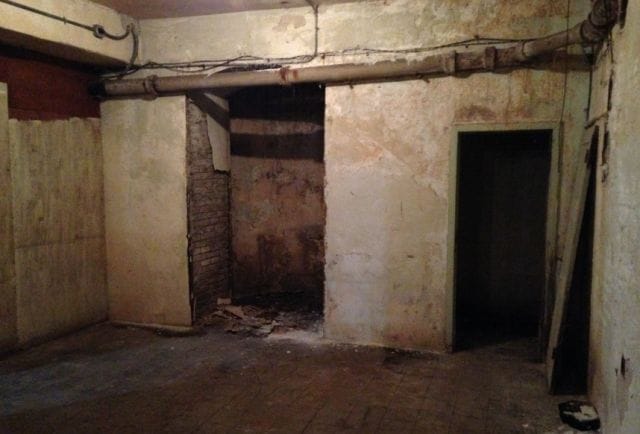
…And the building’s dungeon
Ben Snyder, who has been volunteering with [freespace] for several months, sees great potential for the new space. When a guest inquires about throwing an underground dance party in the basement, Snyder excitedly engages: “We gave this to you — use it for whatever you want. That’s how it works: it’s up to you to make it happen!”
Certainly, people have “made it happen.” The space’s calendar is already rife with events: coloring and cartooning classes, film clubs, meditation — even “philosophical speed dating” (your guess is as good as ours). Stacks of bell peppers, lettuce, fruit, and spinach dip sit by the door, beckoning to be taken home by attendees in need.
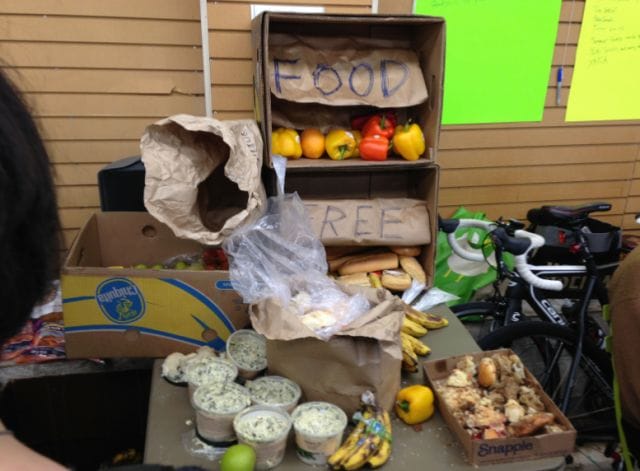
Free food, sourced from local markets
Implications of [freespace]
On their website, [freespace] touts itself as a philosophy and a movement rather than an organization. They provide instructions on how to obtain free or discounted properties, and map out what it takes to spark a successful, community-driven effort: inclusivity, safety, openness, transparency — things city infrastructure often lacks. Similar initiatives have sprouted up in Los Angeles, Paris, the Netherlands, Brazil, and the UK, according to co-founder Mike Zuckerman.
What [freespace] has created is more than a physical arena — they’ve cultivated a unique way of organizing and building local communities. Small, independently-run clubs now have a place to roost; artists and musicians can utilize basements that come without studio fees; hackers and makers can wander in and take advantage of free wi-fi and 3D printers. Best of all, these people share the same space, feed off each other’s creative energy, and expose themselves to a sampler of communities in the city — some of which they’d never find otherwise.
Co-founder Ilana Lipsett says [freespace] is also harnessing a financially sustainable means to influence her city’s cultural landscape:
“We are showing what’s possible in a society where the narrative is that money is required to do anything of substance, and where people exist in increasingly siloed and disconnected worlds.”
Instead, she says, [freespace] runs on the currency of creativity and sharing. By bringing together a diversity of cultures, the movement has created an “ecosystem” of innovation that can improve civic life.
This post was written by Zachary Crockett. Follow him on Twitter here, or Google Plus here.



